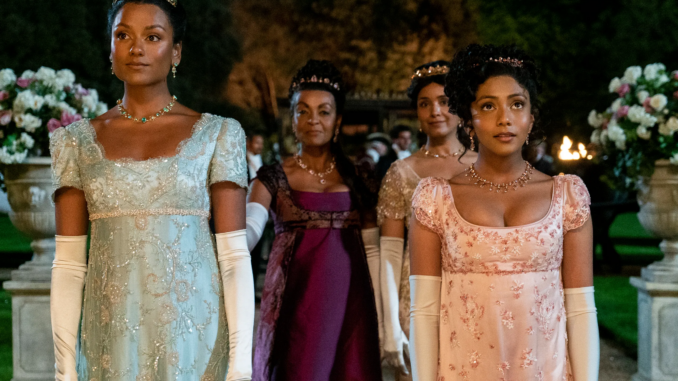
The new season of Bridgerton, in which fan-favorite spinster gossip columnist Penelope Featherington (Nicola Coughlan) finally gets together with her longtime crush Colin Bridgerton (Luke Newton), is just as much of a confection as the preceding two (or three, if you count the prequel, Queen Charlotte). The people are gorgeous, the dresses are stunning, the trees and vines are always perfectly manicured and in bloom, and the action unfolds in a London so green and smokeless you’d barely know the story takes place in the Regency period.
All of this glossy smoothness is what we have come to expect from Bridgerton. Its much-debated multiracial casting practices, which have come accompanied by some small (and, to me, unconvincing) degree of world building explaining Black participation in the aristocracy, create a feeling that this world is a little bit to the side of history, largely unanchored in time and space. To the show’s credit, that’s part of what makes watching it so pleasurable, and other series, like Apple TV+ offering The Buccaneers, have imitated this frothy-fun vibe, to varying degrees of success.

However, this time around, after watching the batch of episodes released as Part 1 of this new season, I—much like the “on-the-shelf” Penelope—confess myself exhausted by standing at the edges of all these endless ballrooms, watching these sumptuously dressed rich people do their dancing and exchange their speaking glances. After the fourth or so installment turning on the events at so-and-so’s musicale or so-and-so’s luncheon, I find myself thirsting for a different setting and different stakes. That second-season flirtation between Eloise Bridgerton and the young printer’s apprentice was awkwardly executed, but Lord help me: I missed it. Just as there are no seasons besides spring in the Bridgerton-verse, there are no real poor, working-class, or middle-class characters in this show. Even the servants don’t have lives. Everything exists to move the pretty people around the ballroom floor.
Of course, this is what the source material—the Bridgerton novels, by Julia Quinn—is like too. Very rarely does anyone who’s not a member of the aristocracy, or at least a wealthy parvenu like Penelope or the illegitimate child of an aristocrat, get a turn in the plot spotlight. Questions of impending deprivation are always kept at the outskirts of the narrative, remaining hypothetical and never threatening the Bridgertons, who are, after all, the people we care about. This family is, thanks to their late father’s and then their punctilious oldest brother Anthony’s fine management of their estate, represented as being quite financially secure. Their unhappiness, if they have any, is in their heads. For the non-Bridgertons of page and screen, questions of financial ruin often loom but never quite seem to strike. The second-season heroine, Kate Sharma, had a “shopkeeper” father and needs to marry her sister off to someone in the aristocracy in order to secure financial support; the Featheringtons always seem to be barely evading some kind of disaster. But at the core of the story is comfort and abundance.
